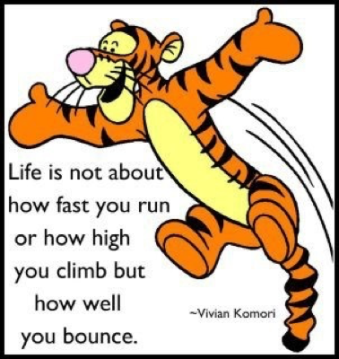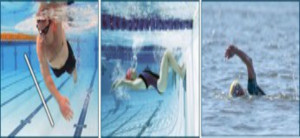Learning How to Bounce
–Written by Sandie Orlando, age group CLPT athlete and experienced ‘bouncer’
Sometimes…stuff happens. As much as we all know this, and have vast amounts of lived experience to reinforce that knowledge – stuff still has a way of taking us by surprise, and messing us up.
Enter the motivational poster based on a quote attributed to just about everyone. “It’s not how many times you fall down, but how many times you get back up.” Wise people everywhere have since evolved that saying to suggest it’s also HOW you get back up. Our ability to bounce is crucial.
Athletes become pretty adept at the bouncing part, when it comes to the physical. Rest – Ice – Compression – Elevation. Pool running. Physio. Chiro. Massage. Elliptical. Time off.
Wait…!!! Time off??!!! Now we’re talking about something completely different. Something athletes are not so good at. And yet – this is often the most important part about bouncing, and also the most difficult.
Accidental crashes aside, any athlete who has suffered an injury (read: all of us) usually senses there is an underlying reason for the injury. Over use. Pushing too hard. Ignoring rest days. Ego taking over. General stupidity. These might seem like reasons, but, in fact, they count as excuses. Reasons go deeper than that, and it takes a good deal of quiet and courageous introspection to look honestly at the underlying causes.
And that’s where the non-physical parts of life come in. The stuff that comes along with being human…like work commitments, family emergencies, health or relationship issues. Now we’re in a category that becomes very difficult to bounce from, because the ‘bottom’ isn’t so obvious – or doesn’t even exist.
While every situation is unique to the person experiencing it, there are some commonalities in how we can find our way through to a turning point. And a turning point may be as close as we can get to a bounce, so learning to recognize it is a big deal…even if it seems only to be appearing off in the distance as a beacon to work towards.
First – and often difficult – is awareness of the situation, with complete honesty and release of judgement. Sometimes this takes reflection. Sometimes this takes talking it through – or writing it out. Or having to explain it to someone who doesn’t even know you, which has a strange effect on how we hear ourselves. (And often comes with embarrassment…’Did I really just say that?”) The opposite approach is to be an ostrich and bury your head in the sand – which only serves to leave your most vulnerable parts exposed. Not worth it.
Next – perhaps more difficult – is acceptance. Until we can actually FEEL the acceptance, we’ll be in vicious circle mode, endlessly repeating the same desperate attempts to bash our way through the same closed doors. When your head aches enough from that, go back to step one and look again.
With acceptance, it’s time to just stop, assess the situation, and ask yourself ‘now what?’ This is when those exercises in creative thinking come in. Look for the second right answer. A different perspective can lead to some important breakthroughs in how we see our situation, which can lead to changes in our thoughts and behavior and attitude.
Sometimes, the very process of shifting how we see things can become the bounce we need to get going again, and the momentum builds from there. But not always.
So – be gentle with yourself – starting with some forgiveness. You want to build on small successes, so give yourself points for just showing up. And if you can’t show up because the stuff got in the way – honour your intention and commitment – and plan for it again. One or two false starts doesn’t count as complete failure – try again. (And give yourself points for trying!)
Finally – acknowledge the small accomplishments as you re-build your momentum from bouncing. Look with fresh eyes at the new approach you’ve adopted, experiment with fine tuning it, and assess whether the direction feels right before you lock it in.
Dr. Suess got it right in his often quoted book “Oh, The Places You’ll Go!” –
So be sure when you step.
Step with care and great tact
And remember that Life’s
A Great Balancing Act.
Just never forget to be dexterous and deft.
And never mix up your right foot with your left.
Bouncing is something we’ll need to do over and over in our lifetime, so it’s another of those great muscles – like confidence – that can be trained. Worth considering next time you are injured, sick or just tangled up in the stuff of life.
–Written by Sandie Orlando, age group CLPT athlete and experienced ‘bouncer’
Ed note: Need help managing your own bounce? For the physical, see Dr. Cindy Lewis www.drcindylewis.com. For the ‘stuff’, try some life coaching with Laura Cerlon @Facebook/LauraCerlon



